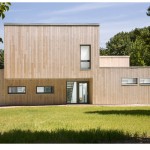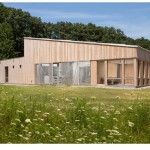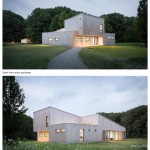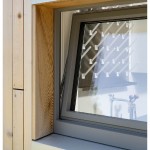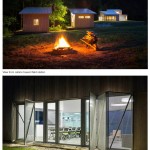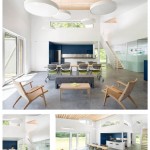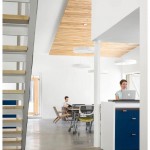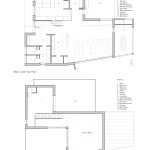Warren Woods Ecological Field Station
Project Name
The University of Chicago’s Warren Woods Ecological Field Station is the first Passive House–certified laboratory in North America, and the fifth in the world. Nestled in 42 acres of land adjacent to Warren Woods State Park in Berrien County, Michigan, the 2,200-square-foot building relates to the climate and functional requirements of the site. The long shed roof volume creates a compact simple building form responding to solar orientation, visitor access and views back to the site. The result is a highly-efficient and self contained building that is in harmony with its surrounding environment.
The Department of Ecology and Evolution at the University of Chicago set out to incorporate an extremely high standard of sustainability for the remote field station, laboratory, and cabins. Used by the Department for research projects, educational programs and classes, as well as departmental retreats and events, the facility offers a fully equipped research laboratory where small groups of students and researchers will grow, process, and study plants. The facility also includes a seminar space, bathrooms, a kitchenette, and three sleeping cabins adjacent to an environmentally significant beech maple climax forest.
The design approach for the field station was to create a compact, highly insulated building shell that makes use of passive solar gains, resulting in a highly energy-efficient facility. The metric used to determine the target level of energy performance for the building was the German Passive House Standard, which represents a 90% improvement on the building’s space heating loads from code-complaint construction.
The laboratory presented a unique challenge to certifying the building given the complex technical requirements and the high levels of heat generated by the research equipment, including plant growth chambers, a negative 80°C freezer, incubators and tools for DNA extraction. Accordingly, the building’s space heating concept was to utilize the lab’s high internal loads and redistributed them into the rest of the building, with heat transfer ducts installed between the spaces to help distribute the warm air.
Architecture or A/E Firm Name
Architect
Team
Consultants
Location
Client
General Contractor
MEASURE 1: DESIGN & INNOVATION
The University of Chicago’s Warren Woods Ecological Field Station is the first Passive House certified laboratory in North America. Nestled in a clearing on 42 wooded acres adjacent to Warren Woods State Park in Berrien County, Michigan, the 2,400 square foot building responds to climatic and functional requirements. The long, shed roof unites the simple building form that integrates solar orientation, visitor access and views of the site. The result is a highly efficient and self-contained building, harmonious with the surrounding environment.
The target threshold chosen by the University of Chicago for the energy performance of the building was the Passive House Standard, which is an 80 to 90 percent reduction in heat demand from building code standards. The requirements of certifying the field station presented a unique opportunity to utilize heat generated by the research equipment to warm the entire building. To prevent overheating, a folding screen provides shade for the seminar space to temper solar gain through the southern glazing. The building is heated with solar gains and air source heat pumps when the research equipment is not in use. The Warren Woods Ecological Field Station sets a precedent for laboratory buildings across the country, further demonstrating the viability of the Passive House approach to sustainable design for all types of buildings.
MEASURE 2: REGIONAL COMMUNITY DESIGN
While the building is contemporary in form, specific attention was paid to reflect characteristics of the rural vernacular in the exterior finish. Vertical white cedar siding, locally sourced from Michigan’s Upper Peninsula, and galvanized metal roofing reflect barn exteriors of the surrounding agricultural community. Further, the natural material contextualizes the building with the surrounding landscape of Warren Woods State Park.
MEASURE 3: LAND USE & SITE ECOLOGY
The objective of the project was to build a certified Passive House field station laboratory with seasonal cabins to accommodate 12 researchers on a remote site in southwestern Michigan. The site harbors several types of habitat currently under ecological restoration, including lowland hardwood forest, climax beech-maple forest and remnant-wet prairie. The field station allows research on biodiversity, evolutionary trajectories, genetic characterization and ecological interactions between species in this habitat as well as botanical experiments in fenced test plots. In order to preform this work, the field station is fully equipped with a laboratory for research projects and a seminar space for educational programs and classes. In addition to accommodating a cutting edge scientific research facility, the field station and its cabins also provide for the scientist’s living and recreational needs. Three seasonal cabins and a bathhouse accommodate up to 12 overnight visitors. The cabins are nestled into the edge of the beach maple climax forest, allowing the cabins to be shaded and cool during the hot summer months, while also providing views into the unique understory of the forest. In the field station, group meals are pre pared in the kitchen and then shared on the screen porch, with views back to the surrounding test plots, cabins and forests.
MEASURE 4: BIOCLIMATIC DESIGN
The field station’s compact form is a response to the rigorous functional and programmatic requirements that simultaneously address the climate and microclimate in which it is built. Three Oaks, Michigan registers 7,200 heating degree-days, qualifying as a “cold” climate. Given the relatively clear skies during the winter months, however, it is an excellent candidate for passive solar gain to offset building heat loss. The building was positioned on site to maximize solar gain, while at the same time balancing the internal gains from the laboratory. To reduce overheating, the laboratory was placed on the comparatively cooler north face of the building. Extensive solar glazing was oriented south for the main seminar space. Perforated steel sliding screen panels used for solar shading and light control, help to reduce unwanted gains in the summer. These elements not only play a critical bioclimatic function for the building, but also create a beautiful layering effect between the interior and exterior.
MEASURE 5: LIGHT & AIR
The intent of the well-insulated and airtight building shell was to achieve a high degree of interior thermal comfort, with light and fresh air distribution by passive means, thereby reducing the need for complex and costly mechanical systems. The building maintains constant indoor temperatures, and is exceptionally well air sealed (registering below 0.6 ACH50 with a blower door test). Two Zehnder ComfoAir heat recovery ventilation system at 88% efficiency provides fresh air in the main spaces, constantly supplying them with filtered and tempered outdoor air, while exhaust air is drawn from the bathrooms and kitchen where humidity and odors are created. During the summer months, passive cooling is provided by the perforated solar screens and by cross ventilation from operable windows. An air-source heat pump supplements heating needs in the winter and provides cooling for the humid Michigan climate during the summer.
MEASURE 6: WATER CYCLE
Newly graded land features direct drainage to preserve and maintain the indigenous ecosystem and stabilize the existing microclimate.
MEASURE 7: ENERGY FLOWS & ENERGY FUTURE
The design approach for the field station was to create a compact, highly insulated building shell that makes use of passive solar gains, resulting in a highly energy-efficient facility that will realize tremendous energy savings over the life span of the building. The metric used to determine the target level of energy performance for the building was the German Passive House Standard, which represents a 90% improvement on the building’s space heating loads from code-complaint construction. The laboratory presented a unique challenge to certifying the building given the complex technical requirements and the high levels of heat generated by the research equipment, including plant growth chambers, a negative 80°C freezer, incubators and tools for DNA extraction. Accordingly, the building’s space heating concept was to utilize the lab’s high internal loads and redistributed them into the rest of the building, with heat transfer ducts installed between the spaces to help distribute the warm air. Essentially, the lab becomes the heating system for the building in the winter.
MEASURE 8: MATERIALS & CONSTRUCTION
The field station was awarded Passive House certification by the Passive House Institute in Darmstadt, Germany and acknowledged as the first Passive House certified laboratory building in North America and the fifth in the world (the first outside Germany). The aspiration to create a long-term sustainable, and affordable research center led to innovations in the building design and construction such as: a highly insulated building shell with R50 walls; R100 roof, R11 triple glazed windows and doors with 50% solar heat gain. The R30 foundation was built using the design team’s recently patented, pre-formed, high compressive strength EPS insulated slab on grade foundation system. This system’s pre-formed components save installation labor, and improves the foundation’s thermal performance, resulting in a less expensive and much higher performing foundation than standard construction. The windows and doors of the field station are aluminum clad triple glazed units, that are highly insulating requiring no maintenance. The exterior siding consists of a locally harvested cedar, that is unfinished and will patina to a silvery gray, reminiscent of the local barns in the area. The roofing is standing seam metal at the sloped roofs and membranes at the flat roofs that are constructed to accept a green roof in the future.
At the interior, the first floor has an exposed polished concrete slab that acts as a thermal mass to help moderate temperature fluctuations achieved by solar gain. To provide material warmth and balance the acoustics of the space, a gaped, naturally finished ash board ceiling was installed over a layer of acoustical batt installation on the large, sloped areas of the ceiling. The stairway is light, transparent and utilizes durable metals for the treads, handrails and guardrails. A glass wall with a fritted gradient pattern was installed between the laboratory and classroom space. The frit pattern transitions from solid at the bottom of the wall, to transparent at the top. This gradient allows a strong visual connection from the lab back to the classroom space at eye level, while providing a visual barrier to the cluttered work surfaces in the laboratory space. These elements support essential building functions while repeating the transparency and layering of the perforated stainless screens on the exterior, allowing the natural light and views to filter and flow in and through the building.
MEASURE 9: LONG TERM FLEXIBILITY AND ADAPTABILITY
To solve for the high internal loads, but maintain Passive House performance levels, the MEP system design had to be quite flexible. Lab equipment gains were easily enough to heat the building in the winter, but to achieve Passive House certification, the gains were discounted to ensure proper Passive House performance in the event that the equipment changed to more energy efficient models. An air source heat pump was an obvious choice to provide flexibility in both heating and cooling scenarios. While the annual heating and cooling requirements are quite low given the intermittent occupancy, the peak cooling load is quite high when the building is fully occupied during the summer. While the heat pump system is larger to meet peak demand, the compressor modulates to achieve the lower Passive House levels consistently.
MEASURE 10: COLLECTIVE WISDOM & FEEDBACK LOOPS
We found that while compact simple forms are certainly an easy pairing with Passive House performance levels, deliberate and specific attention to the building form can yield dynamically beautiful and high performing results. It was exciting to see our assumptions of the possibilities of manipulating building form architecturally bare fruit. That said, more technically-specific mechanical ventilation systems, although expensive, may be better suited to handle the difficult temperature control issues in high internal gain buildings. While the system works well, a higher degree of automation could work even better. Further, the custom screening was quite successful, offering a custom design element at a similar cost to off-the-shelf exterior blinds.

